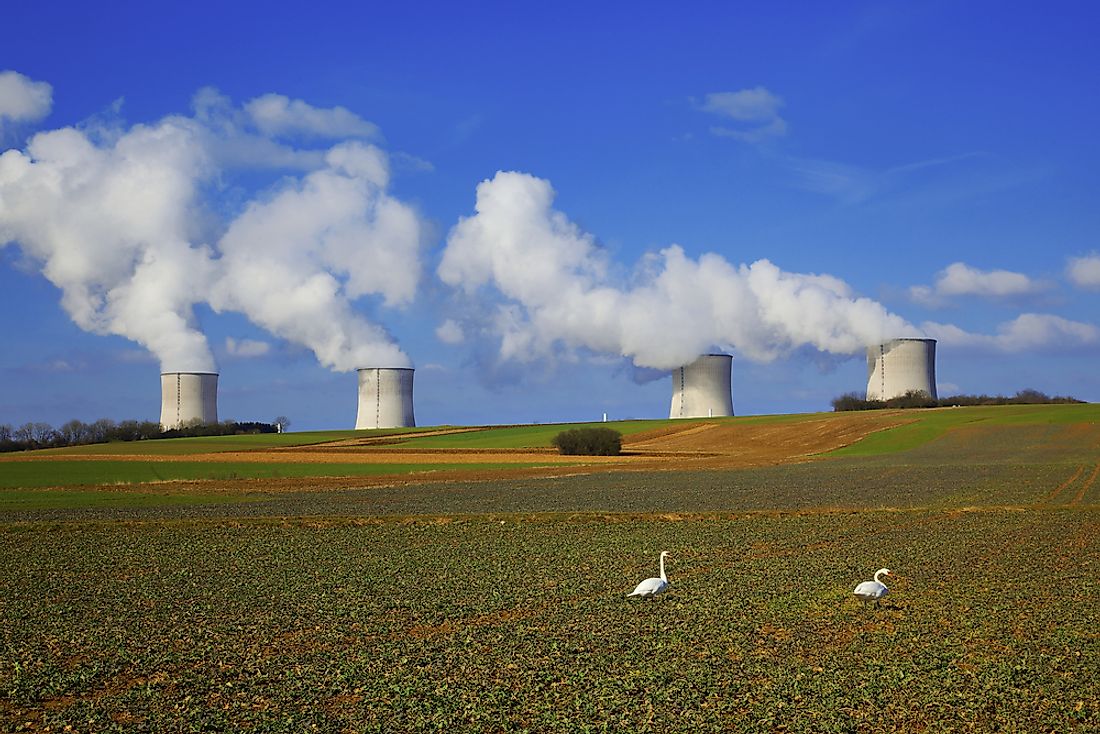Nuclear Power Plants by Country

Electricity generation from nuclear reactors started in the 1950s. Nuclear energy is obtained by fission or splitting isotopes of large atoms like uranium or plutonium. It now supplies around 4% of global electricity and is the fourth largest source of energy. At 99, the United States has more nuclear power plants than anywhere else in the world.
Nuclear Power in a Changing World
There are many advantages and disadvantages to nuclear power. Though production of nuclear energy is cheap, a nuclear plant has a limited operational period. So it is difficult to recover the cost of the capital intensive plant. Moreover, the plant has to be dismantled, and the nuclear waste managed for a long time before it stops being radioactive.
With 58 nuclear reactors, France produced sufficient nuclear power to supply about 78% of its electricity needs. It is the country leading in nuclear power utilization for electricity generation. It also exports surplus nuclear power to neighboring Switzerland, Italy and Belgium. The proportion of nuclear power usage for electricity ranges between 41-60% for Belgium, Hungary, Slovakia, Sweden, South Korea, Bulgaria and Ukraine. The percentage of electricity generated from nuclear sources varies between 30-40% for the Czech Republic, Finland, Switzerland, Bulgaria, Armenia and Slovenia, and 16-20% for Germany, Russia, Canada, the UK, the USA, and Romania. The top producers of nuclear power are developed or transitional economies.
As evident from the table, the majority of these countries- lie in Europe, two in North America, two in Asia and one in South America. US and Ukraine who suffered major nuclear disasters are increasing the share of nuclear power in their energy production. The US, which has 99 reactors, is banking on nuclear power to meet its 2050 carbon emissions targets. The Three Mile Island accident of 1979 stopped new additions for many decades and production was increased only by improving existing reactors. Ukraine, which suffered from Chernobyl, the worst nuclear disaster of all time, plans to add 11 more reactors to its existing 15 plants to double nuclear power.
Future of Nuclear Power
In the aftermath of the Fukushima-Daiichi Nuclear Disaster in 2011, Germany, Switzerland, and Belgium have decided to stop nuclear production completely by 2022, 2035 and 2025 respectively. The French want to reduce their dependence on nuclear to 50%. The Spanish government plans to shut down its nuclear reactors when they have enough electricity from solar and wind power. Many of the countries like, Finland, USA, Sweden, Canada, Ukraine, Russia and possibly South Korea on the other hand. are set to increase the share of nuclear power in electricity generation. Top international organizations, the UN, and Worldbank, who want universal access to electricity, do not support nuclear power, given the risks associated with its use. In the Climate conference in Paris (COP21), 195 countries, however, decided to allow the use of nuclear power to combat climate change.
Countries With the Most Nuclear Power Plants
| Rank | Country | Nuclear Power Plants |
|---|---|---|
| 1 | United States | 99 |
| 2 | France | 58 |
| 3 | Japan | 42 |
| 4 | China | 39 |
| 5 | Russia | 35 |
| 6 | Korea, Republic of | 25 |
| 7 | India | 22 |
| 8 | Canada | 19 |
| 9 | Ukraine | 15 |
| 10 | United Kingdom | 15 |
| 11 | Sweden | 9 |
| 12 | Germany | 8 |
| 13 | Belgium | 7 |
| 14 | Spain | 7 |
| 15 | Czech Republic | 6 |
| 16 | Taiwan | 6 |
| 17 | Pakistan | 5 |
| 18 | Switzerland | 5 |
| 19 | Finland | 4 |
| 20 | Hungary | 4 |
| 21 | Slovakia | 4 |
| 22 | Argentina | 3 |
| 23 | Brazil | 2 |
| 24 | Bulgaria | 2 |
| 25 | Mexico | 2 |
| 26 | Romania | 2 |
| 27 | South Africa | 2 |
| 28 | Armenia | 1 |
| 29 | Iran | 1 |
| 30 | Netherlands | 1 |
| 31 | Slovenia | 1 |











